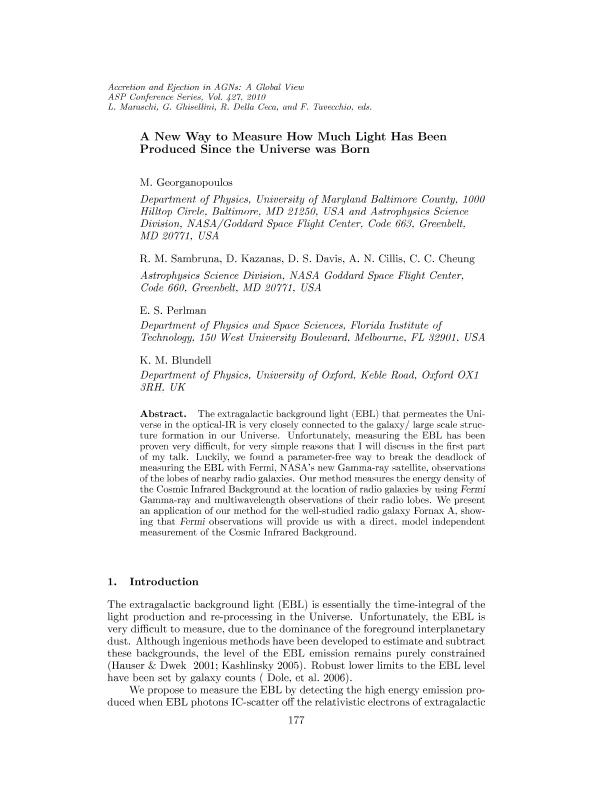Mostrar el registro sencillo del ítem
dc.contributor.author
Georganopoulos, M.
dc.contributor.author
Sambruna, R. M.
dc.contributor.author
Kazanas, D.
dc.contributor.author
Davis, D. S.
dc.contributor.author
Cillis, Analia Nilda

dc.contributor.author
Cheung, C.C.
dc.contributor.author
Perlman, E. S.
dc.contributor.author
Blundell, K. M.
dc.date.available
2017-07-13T21:12:45Z
dc.date.issued
2010-10
dc.identifier.citation
Georganopoulos, M.; Sambruna, R. M.; Kazanas, D.; Davis, D. S.; Cillis, Analia Nilda; et al.; A New Way to Measure How Much Light Has Been Produced Since the Universe was Born; ASP Publications; ASP Conference Series; 427; 10-2010; 177-182
dc.identifier.issn
1050-3390
dc.identifier.uri
http://hdl.handle.net/11336/20437
dc.description.abstract
The extragalactic background light (EBL) that permeates the Universe in the optical-IR is very closely connected to the galaxy/ large scale structure formation in our Universe. Unfortunately, measuring the EBL has been proven very difficult, for very simple reasons that I will discuss in the first part of my talk. Luckily, we found a parameter-free way to break the deadlock of measuring the EBL with Fermi, NASA’s new Gamma-ray satellite, observations of the lobes of nearby radio galaxies. Our method measures the energy density of the Cosmic Infrared Background at the location of radio galaxies by using Fermi Gamma-ray and multiwavelength observations of their radio lobes. We present an application of our method for the well-studied radio galaxy Fornax A, showing that Fermi observations will provide us with a direct, model independent measurement of the Cosmic Infrared Background.
dc.format
application/pdf
dc.language.iso
eng
dc.publisher
ASP Publications
dc.rights
info:eu-repo/semantics/openAccess
dc.rights.uri
https://creativecommons.org/licenses/by-nc-sa/2.5/ar/
dc.subject
Extragalactic Background Light
dc.subject
Fornax A
dc.subject.classification
Astronomía

dc.subject.classification
Ciencias Físicas

dc.subject.classification
CIENCIAS NATURALES Y EXACTAS

dc.title
A New Way to Measure How Much Light Has Been Produced Since the Universe was Born
dc.type
info:eu-repo/semantics/article
dc.type
info:ar-repo/semantics/artículo
dc.type
info:eu-repo/semantics/publishedVersion
dc.date.updated
2017-07-13T14:03:47Z
dc.journal.volume
427
dc.journal.pagination
177-182
dc.journal.pais
Estados Unidos

dc.journal.ciudad
Orem
dc.description.fil
Fil: Georganopoulos, M.. University of Maryland; Estados Unidos
dc.description.fil
Fil: Sambruna, R. M.. National Aeronautics And Space Administration. Goddart Institute For Space Studies; Estados Unidos
dc.description.fil
Fil: Kazanas, D.. National Aeronautics And Space Administration. Goddart Institute For Space Studies; Estados Unidos
dc.description.fil
Fil: Davis, D. S.. National Aeronautics And Space Administration. Goddart Institute For Space Studies; Estados Unidos
dc.description.fil
Fil: Cillis, Analia Nilda. Consejo Nacional de Investigaciónes Científicas y Técnicas. Oficina de Coordinación Administrativa Ciudad Universitaria. Instituto de Astronomía y Física del Espacio. - Universidad de Buenos Aires. Facultad de Ciencias Exactas y Naturales. Instituto de Astronomía y Física del Espacio; Argentina
dc.description.fil
Fil: Cheung, C.C.. National Aeronautics And Space Administration. Goddart Institute For Space Studies; Estados Unidos
dc.description.fil
Fil: Perlman, E. S.. University of Florida; Estados Unidos
dc.description.fil
Fil: Blundell, K. M.. University of Oxford; Reino Unido
dc.journal.title
ASP Conference Series
dc.relation.alternativeid
info:eu-repo/semantics/altIdentifier/url/http://aspbooks.org/custom/publications/paper/427-0177.html
Archivos asociados
